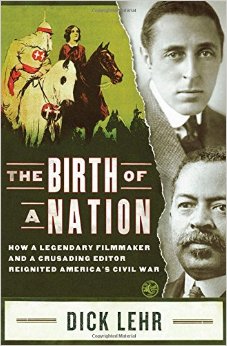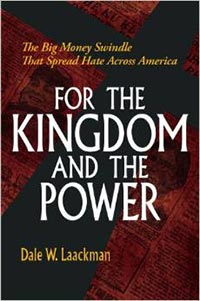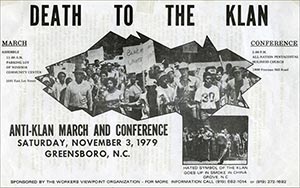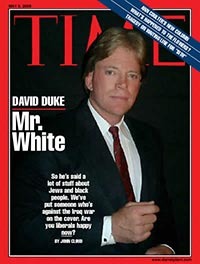Editor’s Note: This column is the second in a two-part series detailing the making of D.W. Griffith’s controversial film The Birth of a Nation. Griffith set a new standard for cinematic achievement with his epic production. But the film’s portrayal of African Americans in post-Civil War society as ignorant, predatory, and unsuited to citizenship helped set in motion a series of devastating social and political setbacks, the effects of which can still be felt today. Read Part I.
The long political reach of The Birth of a Nation
In my opinion D.W. Griffith’s The Birth of a Nation, which observed its centennial on Feb. 8, is arguably a motion picture whose lasting social and political implications are unlike any other.
The film’s controversial second half was drawn almost entirely from Thomas Dixon’s 1905 novel The Clansman. The novel offered a fierce diatribe against those who were seen as having sought to “foist” Reconstruction on the South; and in the end it glorified the insurgent rise of the Ku Klux Klan as a necessary means of defeating Reconstruction “outsiders” who in Dixon’s words had made “a bold attempt … to Africanize 10 great states of the Union.”
From day one critics rose up in protest of The Birth of a Nation’s ideological claims. Francis Hackett, a writer for The New Republic, summed up what many disapproving critics thought about the film: “Whatever happened during Reconstruction, this film is aggressively vicious and defamatory,” Hackett wrote. “It is spiritual assassination.”
Early protests
 Protestors rallied in Boston, birthplace of the abolitionist movement, soon after Griffith’s film opened at the Tremont Theatre on April 5, 1915. Monroe Trotter, founder/editor of The Guardian, spearheaded the crusade against The Birth of a Nation. Trotter, whose father had served in an all-black regiment during the Civil War, wrote editorials and published letters protesting the film, calling on Boston’s mayor and other public officials to have the film removed from the Tremont.
Protestors rallied in Boston, birthplace of the abolitionist movement, soon after Griffith’s film opened at the Tremont Theatre on April 5, 1915. Monroe Trotter, founder/editor of The Guardian, spearheaded the crusade against The Birth of a Nation. Trotter, whose father had served in an all-black regiment during the Civil War, wrote editorials and published letters protesting the film, calling on Boston’s mayor and other public officials to have the film removed from the Tremont.
Later efforts were made to censor the film, and a consequent battle over free speech rights ensued. Trotter and W.E.B. Du Bois, who had been leaders in the founding of the NAACP, joined with large numbers of black protestors outside the Tremont, and the Boston police force had to be summoned to suppress the racial uprising.
While Trotter had been successful in 1910 at having Thomas Dixon’s stage version of The Clansman banned from Boston theaters, he lost his crusade against The Birth of a Nation. The full story of the Trotter-led protest campaign is the subject of Dick Lehr’s 2014 book The Birth of a Nation: How a Legendary Filmmaker and a Crusading Editor Reignited America’s Civil War (Public Affairs/Perseus Books).
The NAACP continued to publish and distribute materials about the offensive nature of the film, with much of its criticism aimed at Dixon. who had been defiant in making claims that his interpretation of post-Civil War history was absolute truth.
In October 1915 the NAACP’s Crisis magazine published an editorial cartoon titled “The Verdict,” which depicted Dixon sitting in a courtroom before a judge and a jury of “fair-minded Americans.” The trial lawyer holds a scroll that reads “As a HISTORIAN we find the defendant a pretty good LIAR.”
“The tragic legend”
So why was Dixon so confident about his interpretation of Reconstruction history in his novel The Clansman and on the screen in The Birth of a Nation?
A historical review of the period between 1872, the year the original Klan was driven out of business by the Federal Force Acts, and 1915, the year of The Birth of a Nation’s release, reveals the progressive development of a stereotyped and mythic view of Reconstruction — the evolution of what historians would label “the tragic legend of Reconstruction.”
This legend grew in large part from the many romanticized pro-Klan novels written in the latter part of the 19th century, novels which, according to historian William Pierce Randall, “conditioned several generations to tolerate the old Klan as an agency striving to preserve a beautiful civilization in its unequal conflict with the materialistic North.” (The Ku Klux Klan: A Century of Infamy, 1965). In Media Made Dixie: The South in the American Imagination (1978) Jack Temple Kirby concurs: “Reconstruction — a trauma within the memory of many in 1900 — became a foolish, tragic misadventure instead of a noble conclusion to the abolitionist crusade. All that remained at the opening of the new century was further synthesis and broadcast.”Dixon’s novel and Griffith’s epic film would provide that synthesis and broadcast
Toxic influence
What have historians cited as inaccuracies in the Dixon-Griffith views?
Revisionist interpretations of the period following the Civil War refute the claim that Reconstruction was a premeditated act of revenge by radical northerners. To the contrary, historian Emory M. Thomas, in his 1973 book The American War and Peace 1860-77, maintains that Reconstruction was an effort by Northern idealists to achieve racial justice. The program failed, he says, “not because of injustices done to Southern whites, but because of injustices done to Southern blacks, and because of the larger challenge to face up to racial pluralism.” This view is very much at odds with the Dixon-Griffith pro-Klan interpretation of what brought down Reconstruction.
Also misleading and innaccurate: The Birth of a Nation’s degrading account of newly elected political leaders as shown in the scenes of the predominantly black South Carolina legislature of 1871. While inexperienced blacks ascended to political office during Reconstruction, many educated and well-qualified black leaders also held political power. Historian Samuel Eliot Morison in the Oxford History of the American People (1965) asserts that black legislators never attempted, as shown by Dixon and Griffith, “to domineer over or pass vindictive legislation against their former masters.”This aspect of Reconstruction history is fully treated by Thomas C. Holt in his prize-winning book Black Over White: Negro Political Leadership in South Carolina During Reconstruction.(University of Illinois Press, 1978).
The most egregious inaccuracy in The Birth of a Nation is the glorified characterization of the Ku Klux Klan as a benevolent and relevant organization acting on behalf of a beleaguered people. On the contrary, the Klan and other “secret” groups of the time committed acts of terror and violence — lynchings and intimidating night rides — humiliating acts born of hatred. Most people in the country — North and South — found these organizations despicable. Even the Ku Klux Klan’s first leader, General Nathan Forrest, had — out of concern — withdrawn from the organization by 1869.
Many other elements of the Dixon-Griffith interpretation of reality have been refuted by historical research: the depiction of the Freedman’s Bureau as a part of the corrupt leadership of Reconstruction rule, and the singling out of Thaddeus Stevens as a vindictive Republican leader who is quoted in The Clansman saying “My will alone forged the chains of Negro rule.” That view also became a significant part of “the tragic legend of Reconstruction.”
In spite of the efforts to “convict” Dixon as a liar, public interest in The Birth of a Nation remained high for years. It is estimated that from 1915-17, some 25 million people paid to see the film. Awe-struck critics were lavish in their praise for the film’s cinematic powers.
Propaganda tool
The political reach of The Birth of a Nation has indeed been long and fascinating. Since its 1915 release the film has commanded a provocative interrelationship with the rechartered contemporary Ku Klux Klan — first as the inspiration for the rebirth of the organization in December 1915, and second as a long-serving mouthpiece for the Klan’s views.
On Thanksgiving Day in 1915 William Joseph Simmons, whose father had been a member of the original Klan, led a group of men to the top of Stone Mountain, Ga. There they burned a cross in symbolic anticipation of establishing a new Klan. On Dec. 4, Simmons received a charter from the state of Georgia for an organization to be called the Invisible Empire, Knights of the Ku Klux Klan.
 Simmons’ revival of the Klan had been calculated to coincide with the opening of The Birth of a Nation in Atlanta on Dec. 6, 1915. Although Griffith immediately denied that his film was in any way connected to the new Klan, his dramatic idealization of past history provided a culminating moment of inspiration that would forever link the film with modern political history.
Simmons’ revival of the Klan had been calculated to coincide with the opening of The Birth of a Nation in Atlanta on Dec. 6, 1915. Although Griffith immediately denied that his film was in any way connected to the new Klan, his dramatic idealization of past history provided a culminating moment of inspiration that would forever link the film with modern political history.
Simmons’ Knights of the Ku Klux Klan remained a fledgling secret organization until its membership ranks swelled in the 1920s with the help of two Atlanta marketing/public relations executives — Elizabeth Tyler and E.Y. Clarke, Jr. Using promotional strategies to arouse fear and suspicion of “outsiders” — blacks, Jews, Catholics, and European and Asian immigrants — white Protestant Americans began joining the Klan in massive numbers.
It was an era of staggering inflation and unemployment. In due time there would be several million men and women on the Klan’s largely secret rolls — with members in every state of the Union. The Clarke-Tyler “Klan propagation” team became extraordinarily rich through the sharing of membership fees and the sale of Klan costumes and regalia.
While calling itself a fraternal organization the power of the burgeoning Klan was able to keep in place restrictive Jim Crow laws that after Reconstruction had legalized racial discrimination and segregation of blacks.
The story of the remarkable growth of the Ku Klux Klan of the 1920s is comprehensively developed in For the Kingdom and the Power: The Big Money Swindle that Spread Hate across America (S. Woodhouse Books, 2014) authored by Dale Laackman, MA ’74.
The membership of the second-era Ku Klux Klan began to diminish after its peak in the 1920s, but hardcore Klan members and their leaders would continue to use the organization’s “disregard-of-outsiders” ideology throughout the 20th century, and as a result The Birth of a Nation served as a propaganda vehicle for ultra-conservative white supremacist groups who took to showing the film at group gatherings for advocacy purposes.
The interview, part 1
My research on The Birth of a Nation in the 1970s and ’80s grew from newspaper reports about incidents involving Griffith’s film. Klan activism had picked up during the ’70s. On July 31, 1978, in racially tense Oxnard, Calif., and on July 9, 1979, in China Grove, N.C., public disorders occurred as a result of the film’s screening. These outbursts were spawned by the fact that The Birth of a Nation had come to be seen as an identifiable, concrete manifestation of white supremacist dogma.
Much in the news at the time was Louisiana Klan leader David Duke who was known to screen the film at public gatherings. In 1984 I interviewed both Duke and Gorrell Pierce, the 1979 Grand Dragon of the Federated Knights of the (North Carolina) Ku Klux Klan. Both men were known to show the film for advocacy purposes.
My questions focused on their continued use of a silent film produced six decades earlier. In a phone interview with Duke at his home in Metairie, La., he spoke of the “historical value” of The Birth of a Nation: “The average person who sees it gets a good view of what Reconstruction was all about — the disenfranchisement of whites,” Duke said at that time. “No film or television program today can give the pro-Klan position as effectively as The Birth of a Nation.”
Duke went on to say the film “shows the importance of bonding together. We feel the races are different. We are separationists rather than supremacists.”
The interview, part 2
During my interview with Pierce, I learned that he provided a “historical” narration during film screenings that he felt explained the nature of Dixon’s book and Griffith’s film.
I spoke with Pierce at his home outside Winston-Salem about his intentions.
“We use the film to explain what the Klan was and to dispel ignorance,” he said. “People don’t understand that we — the South — were occupied by foreign troops. We use the film to inform people of this fact… (It helps) you to see who you are in relation to white people historically. What you carved out of this country.”
In response to why members join and who they are, Pierce replied: “They join out of economic frustration. There are no stereotypes. In 1979 some of our members were well-heeled, some dirt poor, some college-educated, some didn’t get out of fifth grade. We even had some Catholics. Commonly, all white, Anglo-Saxon Americans — a true cross section.” (Thus a Klan leader’s view of what constitutes a “true cross section.”)
The film that won’t go away
The Birth of a Nation’s periodic re-emergence has been as a propaganda tool for shaping political ideology, most notably a fundamental belief of disregard for outsiders. In the Dixon-Griffith exchange the outsiders were carpetbaggers, Freedmen Bureau organizers, corrupt “leaders” sent from the north, teachers, and other professionals who contributed to the post-war Reconstruction effort.
To a significant degree the original Klan came about as a result of a frustrated reaction to Reconstruction efforts at altering, for diversity’s sake, the Southern agrarian economy. The economic frustration of the “second-era” Klan of the 1920s largely blamed the influx of immigrants for the country’s problems.
As Pierce indicated to me in his interview, “economic frustration” has remained a key element of Klan activism. The Oxnard, Calif., riot, rising from the screening of The Birth of a Nation, occurred in a racially diverse city where the competition for jobs was intense.
 The China Grove, N.C., incident resulted from tensions that had grown from the presence of labor organizers in the textile-rich Piedmont region of the state. An advocacy showing of Griffith’s film at a community center was disrupted by anti-Klan protesters who later staged a “Death to the Klan” march in nearby Greensboro on Nov. 3, 1979.
The China Grove, N.C., incident resulted from tensions that had grown from the presence of labor organizers in the textile-rich Piedmont region of the state. An advocacy showing of Griffith’s film at a community center was disrupted by anti-Klan protesters who later staged a “Death to the Klan” march in nearby Greensboro on Nov. 3, 1979.
During the rally four protest marchers were shot and killed by Ku Klux Klan and American Nazi party members. That event became known as the Greensboro Massacre. The five defendants in the trials against the Klan and Nazi party members were acquitted by all-white juries.
The Greensboro Massacre can be viewed as another instance of hate crimes committed against outsiders. Only a decade-and-a-half earlier opposition to the Civil Rights Movement of the 1950s and ’60s by Klan and Klan-like dissidents had resulted in the murder of dozens of activists. A year after the passage of the 1964 Civil Rights Act a “CBS Reports” program on the modern Klan showed The Birth of a Nation being projected at a Klan meeting as, in Charles Kuralt’s pointed words, “a classic example of what other generations did to preserve white supremacy.”
In her response to my August, 2014 article on the making of The Birth of a Nation, U-M Professor of History, Law, and Afroamerican and African Studies Martha S. Jones wrote about the role The Birth of a Nation played in “ensuring the end of Reconstruction’s achievements and the establishment of a Jim Crow social, political, and legal order.” In her Aug. 25, 2014, letter to the editor of Michigan Today she noted, “When we teach the history of Reconstruction, The Birth of a Nation is often required viewing, precisely because it is one of the cultural products that helped engender the deep misunderstandings that characterized the first half of the 20th century, and that linger into our own time.”
Over the years several thousand students in my own classes saw and discussed Griffith’s film for the same reasons articulated by Professor Jones, when she says: “No student at the University of Michigan should miss the opportunity to understand Griffith’s cinematic achievement. Still, no study of the film would be complete without also explaining its toxic influence on the longer story of race and rights in the United States.” Similarly, Julian Bond and other Civil Rights leaders continue to urge that the film be seen and analyzed for that very reason.





rex hauser - 1978,1980,1988
Thank you, Frank, for yet another fine examination of film
history, which in this case is so alive and pertinent to all of our lives.
I have fond memories of the wonderful opportunities for film study at UM,
of which i reaped the benefits in my senior year (’77-’78) there. I can brag also about the many campus film group and ‘art house’ offerings of the late sixties and early seventies, when Ann Arbor gave so many of us a window on the world. As a townie before i even thought to be a ‘gownie,’ i was so fortunate to have been raised on a feast of film.
Reply
James R. Foreman - Phd, Atmospheric Science, 1986
Might it be that one aspect of this film has been misunderstood?
Take a good look at the Klansmen’s headgear (I haven’t done this,but I am curious). From a distance, the headgears looks like they could be “plungers” or “plumbers’ helpers”, devices used by plumbers to unclog stuck toilets. Might Mr Griffith have been calling the Klansmen “toilet heads”?
Just a thought.
Reply